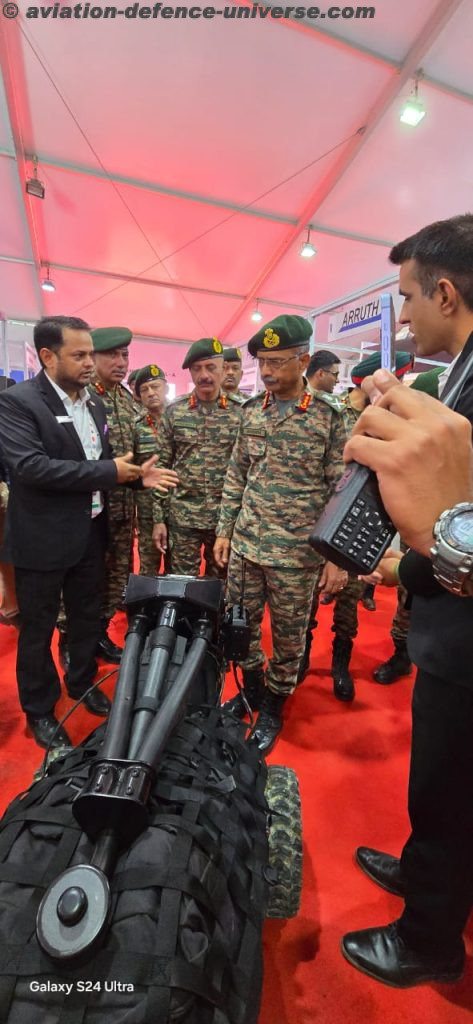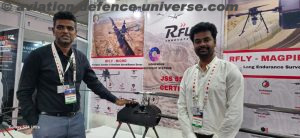- Pushes Defence Innovation for High-Altitude Operations
- Private sector showcases indigenous solutions for High-Altitude Warfare
By Sangeeta Saxena
Leh, Ladakh. 21 September 2024. HIMTECH 2024, organized in collaboration with the Indian Army and FICCI, received an enthusiastic response from the defense and technology sectors. Over 90 companies from various industries participated, showcasing cutting-edge innovations tailored to high-altitude operations. Exhibitors presented a range of solutions, including autonomous systems, green energy, human sustainability, equipment maintenance, waste management, communication technologies, and infrastructure development.
The symposium highlighted India’s focus on leveraging indigenous technology to enhance operational capabilities in extreme conditions, underscoring the nation’s commitment to self-reliance and technological advancements under Atmanirbhar Bharat.
As modern military operations increasingly shift to complex terrains, high-altitude warfare has become a critical aspect of national defence strategies. Areas like the Himalayas, with their towering peaks and extreme environments, represent significant strategic importance for countries like India, where maintaining a strong presence in these high-altitude zones is essential for border security and sovereignty.
High-altitude warfare presents unique challenges that are vastly different from conventional warfare at lower altitudes. Soldiers deployed in these regions must contend with extreme cold, low oxygen levels, unpredictable weather patterns, and rugged terrain. These conditions not only affect personnel but also impact the performance and longevity of equipment and machinery.
In high-altitude areas, temperatures can drop to -30°C or lower, causing both mechanical and physiological stress. Equipment tends to malfunction due to freezing conditions, while personnel face reduced stamina, cognitive performance, and increased risk of high-altitude illnesses. The thin air at altitudes above 12,000 feet reduces oxygen availability, making it harder for both humans and machinery to operate efficiently.
These extreme conditions also pose logistical challenges, as road disruptions caused by landslides, avalanches, and snowstorms hinder the movement of troops and supplies. Helicopters, often the primary means of transportation in such regions, struggle to perform optimally in low-oxygen environments, adding to the difficulty of maintaining effective supply chains.
The Importance of Sustainability Equipment
In the face of these challenges, the sustainability of troops and equipment becomes paramount. To ensure long-term operations and readiness in high-altitude areas, military forces rely heavily on specially designed sustainability equipment. This includes innovations in life-support systems, specialized clothing, shelter solutions, and technologies that enhance equipment reliability in harsh environments.
Life-Support Systems
Troops in high-altitude regions require advanced life-support systems, such as oxygen concentrators, portable medical devices, and heating systems to maintain health and operational efficiency. Personal gear, like high-altitude boots, heated clothing, and insulated tents, plays a critical role in protecting soldiers from frostbite and hypothermia.
Green Energy Solutions
With traditional power sources often unreliable in remote areas, green energy systems such as solar panels, wind turbines, and hybrid generators are being adopted to sustain both personnel and equipment. These renewable energy solutions help reduce the reliance on fuel supplies, which are difficult to transport through mountainous terrains.
Autonomous Systems
Unmanned vehicles and drones designed to operate in harsh conditions can significantly improve supply chains and surveillance efforts. Autonomous systems not only enhance situational awareness but also reduce the risk to human lives in extreme weather conditions by carrying out essential tasks like supply drops, reconnaissance, and communication relay in high-altitude environments.
Equipment Durability and Maintenance
The longevity of military equipment in high-altitude regions is crucial. Specialized vehicles, such as high-altitude snowmobiles and all-terrain vehicles, must be equipped with engines that can function efficiently in low-oxygen conditions. Moreover, maintenance equipment, such as portable repair tools and diagnostic systems, must be resilient and easy to use in freezing temperatures, ensuring that critical equipment can be repaired on-site without requiring transport to lower altitudes.
Waste Management Solutions
Sustainability in high-altitude warfare also includes efficient waste disposal systems. In areas where environmental impact can be severe, eco-friendly waste management technologies are essential for reducing pollution and preserving the fragile ecosystem. These systems not only protect the environment but also prevent the spread of diseases and maintain the health of personnel stationed in these regions for extended periods.
Strategic Importance of High Altitude Warfare
High-altitude regions often serve as natural borders between nations, making control over these areas vital for national security. In the case of India, the Himalayas represent both a strategic barrier and a line of defense against adversarial threats. Controlling these regions ensures not only territorial integrity but also safeguards critical access points for resources and trade routes.
The geopolitical significance of high-altitude warfare has been underscored in several modern conflicts, where nations vie for control over key mountain passes and plateaus. The ability to deploy and sustain forces in these regions gives a tactical advantage in both defensive and offensive operations.
The Path Forward: Leveraging Technology for Sustainability
The future of high-altitude warfare lies in the continuous development and integration of advanced technologies that enhance both human and machine performance in extreme conditions. Recent advancements in artificial intelligence (AI), robotics, and bio-engineered materials are expected to revolutionize sustainability equipment for high-altitude warfare.
For example, AI-powered systems can monitor troop health, equipment status, and environmental conditions in real time, providing commanders with critical information to make rapid decisions. Innovations in materials science are also leading to the development of lighter, stronger, and more durable equipment that can withstand the harshest conditions without sacrificing mobility.
Moreover, India’s focus on self-reliance under the Atmanirbhar Bharat initiative is fostering the growth of indigenous defence industries, which are working on cutting-edge solutions for high-altitude warfare. From drone technologies to green energy systems, these innovations are poised to not only meet domestic defence needs but also position India as a global leader in defence technology for challenging environments.
High-altitude warfare is a demanding but essential aspect of modern military strategy, especially for countries with mountainous borders like India. Sustaining military operations in these regions requires a robust combination of advanced technology, innovative equipment, and well-trained personnel. The development of sustainability equipment plays a critical role in ensuring that soldiers can operate effectively and maintain their combat readiness in these extreme conditions.
As high-altitude regions become increasingly contested in global geopolitics, the ability to leverage indigenous technology and create sustainable solutions will be key to maintaining strategic superiority. Through continued innovation, India is not only addressing the challenges of high-altitude warfare but also setting the stage for future success in some of the world’s most unforgiving environments.
Severe cold, low oxygen levels, and low humidity present critical challenges for troops stationed in high-altitude areas. These harsh conditions make equipment maintenance and personnel survival increasingly difficult. Frequent road disruptions due to avalanches, landslides, and rugged terrain, combined with adverse weather, further complicate road and air movements. The symposium aimed to harness advanced technology to address these challenges and boost combat readiness. It highlights India’s commitment to enhancing military capabilities through indigenous innovation, aligning with the vision of Atmanirbhar Bharat.
The Lieutenant Governor of the Union Territory of Ladakh, Brig (Dr) BD Mishra (Retd), visited Him Tech Symposium 2024 in Leh on Day 2. During the event, he delivered a keynote address and interacted with key stakeholders from the Indian Defense Industry and military personnel.
Him Tech Symposium 2024 was inaugurated by Lt Gen MV Suchindra Kumar, PVSM, AVSM, YSM*, VSM, GOC-in-C, Northern Command at Rinchen Auditorium, Leh on 20 Sep 2024. Him Tech Symposium 2024 has been organised by the Indian Army in coordination with the Federation of Indian Chambers of Commerce and Industry (FICCI). Military and civil dignitaries including Mr SP Shukla, Chairman FICCI attended the event. Lt Gen Hitesh Bhalla, SC*, SM, VSM, GOC Fire and Fury Corps delivered the welcome address. The symposium provided a platform for Indian Defence Industry to showcase their products. This year the theme of the symposium was “Harnessing Defence Technology for High Altitude Areas”.
During the inauguration ceremony, the Him Tech 2024 compendium was unveiled. Senior military officers and dignitaries visited the Expo Stalls set up at Rinchen Auditorium in Leh and interacted with the Indian Defence Manufacturers. Indian Army organised a display of ideas and innovations to highlight the advancements and modifications made by its personnel based on the day to day challenges being faced by them and their ingenious solutions. This was a valuable opportunity for Indian defence manufacturers to gain insight into real challenges and requirements. Him Tech 2024 offered a crucial platform for defence forces, industry leaders and technology innovators to collaborate and tackle the challenges of high altitude warfare. The event exemplified the spirit of self-reliance embodied by the Atmanirbhar Bharat initiatives. The symposium was open to the public from 21st afternoon to closing of the show the same evening.































































































































